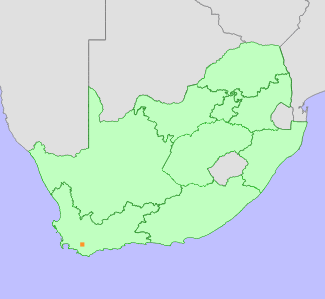|
Scientific Name | Sorocephalus crassifolius Hutch. |
Higher Classification | Dicotyledons |
Family | PROTEACEAE |
Common Names | Flowerless Clusterhead (e) |
National Status |
Status and Criteria | Critically Endangered (Possibly Extinct) |
Assessment Date | 2020/08/13 |
Assessor(s) | A.G. Rebelo, H. Mtshali, D. Raimondo & N.A. Helme |
Justification | Sorocephalus crassifolius has experienced a population reduction of over 80% as estimated based on an 89% decline in the number of subpopulations known through herbarium records in the past 100 years (generation length >100 years). Despite extensive searches, two subpopulations on Jonaskop, where the habitat is still intact, could not be relocated and are presumed extinct. This species was last recorded flowering in the 1980s. Subpopulations were small and declining due to apparent recruitment failure. Only 11 plants remained in 2001 and this species is now possibly extinct, as surveys to search for it between 2010 and 2015 have not been successful. It is therefore listed as Critically Endangered Possibly Extinct. |
Distribution |
Endemism | South African endemic |
Provincial distribution | Western Cape |
Range | This species is limited to Riviersonderend Mountains, in the Western Cape Province, South Africa. |
Habitat and Ecology |
Major system | Terrestrial |
Major habitats | South Sonderend Sandstone Fynbos |
Description | It occurs in peaty ledges and seeps on steep, upper south-facing sandstone slopes, at high altitudes (1200-1450 m). It is a long-lived species, and survives fires by resprouting from an underground rootstock. Seeds are released after ripening, and dispersed by ants to their underground nests, where they are protected from predation and fire. It is pollinated by insects. |
Threats |
| The reason for the population declines recorded over a 10 year period between 1992 and 2002 is not known, but may be related to apparent recruitment failure: no flowers have been seen since the 1980s. |
Population |
Monitoring of small subpopulations during the Protea Atlas Project (1991-2001) recorded unexplained declines in four known subpopulations. One subpopulation recorded in 1992 could not be relocated in 1996. No plants could be located at a well-explored site, on Jonaskop, where the species is known from historical records. The two remaining subpopulations (in 1996) had less than 10 plants each. Since then it has not been observed and is possibly extinct.
|
Population trend | Decreasing |
Conservation |
| It is conserved in Riviersonderend and Greyton Nature Reserves. |
Notes |
| This is an extremely cryptic resprouter. It is well camouflaged by Clutia alaternoides, and even intensive searching can miss plants, which are very small, unlike other Proteaceae resprouters which typically show rapid growth in post fire conditions. However, healthy plants should not be that difficult to find and the declines observed over the past 30 years are considered valid. |
Assessment History |
Taxon assessed |
Status and Criteria |
Citation/Red List version | | Sorocephalus crassifolius Hutch. | CR A2c; C2a(i); D | Raimondo et al. (2009) | | Sorocephalus crassifolius Hutch. | Vulnerable | Hilton-Taylor (1996) | | Sorocephalus crassifolius Hutch. | Vulnerable | Hall et al. (1980) | |
Bibliography |
Goldblatt, P. and Manning, J.C. 2000. Cape Plants: A conspectus of the Cape Flora of South Africa. Strelitzia 9. National Botanical Institute, Cape Town.
Hall, A.V., De Winter, M., De Winter, B. and Van Oosterhout, S.A.M. 1980. Threatened plants of southern Africa. South African National Scienctific Programmes Report 45. CSIR, Pretoria.
Hilton-Taylor, C. 1996. Red data list of southern African plants. Strelitzia 4. South African National Botanical Institute, Pretoria.
Manning, J.C. and Goldblatt, P. 2012. Plants of the Greater Cape Floristic Region 1: The Core Cape Flora. Strelitzia 29. South African National Biodiversity Institute, Pretoria.
Raimondo, D., von Staden, L., Foden, W., Victor, J.E., Helme, N.A., Turner, R.C., Kamundi, D.A. and Manyama, P.A. 2009. Red List of South African Plants. Strelitzia 25. South African National Biodiversity Institute, Pretoria.
Rebelo, T. 2001. Sasol Proteas: A field guide to the proteas of southern Africa. (2nd ed.). Fernwood Press, Vlaeberg, Cape Town.
|
Citation |
| Rebelo, A.G., Mtshali, H., Raimondo, D. & Helme, N.A. 2020. Sorocephalus crassifolius Hutch. National Assessment: Red List of South African Plants version 2024.1. Accessed on 2025/12/02 |
 Comment on this assessment
Comment on this assessment

